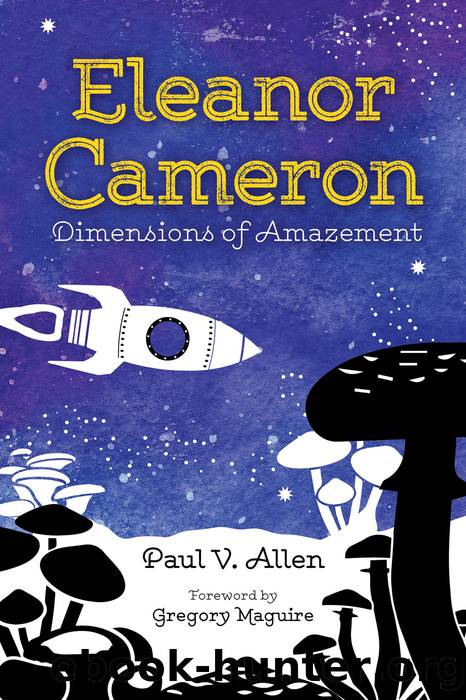Eleanor Cameron by Paul V. Allen

Author:Paul V. Allen
Language: eng
Format: epub
Publisher: University Press of Mississippi
Published: 2018-04-15T00:00:00+00:00
Fantastic Reality (1973â1976)
I believe this is the greatest privilege anyone can be given ⦠the opportunity of living at the top of oneâs powers, at least for part of oneâs life-time.
âMYRA WILDING, PORTRAIT OF AN UNKNOWN WOMAN, 1950 (UNPUBLISHED)
While the drama of her Little, Brown departure was winding down, Eleanor suffered a physical injury to go along with the emotional ones. In late January 1973 she slipped on the polished linoleum floor of the Sunset Auditorium in Carmel, where she was attending a chamber music concert. She heard a crack in her knee and was rushed to the hospital with a broken patella. There was an operation and a weekâs stay at the hospital. She was sent home with a thigh to ankle cast and lots of sedentary time. Though this seems ideal for a person who loves to read, Eleanor found the downtime tedious, at least partially because the painkillers made her foggy. She got a smaller cast in mid-February and had that for a few weeks before starting physical therapy. She wrenched it again that May, but eventually recovered fully. The comparison to her motherâs childhood knee troubles was not lost on Eleanor.
*â*â*
As far back as 1969 Eleanor had been considering where she might go if things fell through with Little, Brown. She mentioned Viking (because her friend Doris Gates was there), Harcourt (but only if Margaret McElderry would be her editor), Holt, Rinehart, & Winston (where Ann Durell served as editor to Eleanorâs friend Lloyd Alexander), and Atheneum (home of Ursula Le Guin). In the end it was none of these, but Dutton that became her second and final publisher. Ann Durell had transferred there in 1969, and when Eleanor made the decision to leave Little, Brown she âwent to the phone and called Ann in New York, asked if she wanted meâand she said, Are you kidding?ââ
Ann Durell actually had some things in common with Emilie McLeod: Both attended Mount Holyoke College, and both had tried their hand at writing books before focusing fully on editing (in Annâs case Holly River Secret in 1956, My Heartâs in the Highlands in 1958, and Lost Bear in 1959). However, Eleanor felt Ann shared her elevated view of childrenâs books as literature where Emilie did not. And they got along personally; at that point, Eleanor had known Ann for a while and found her to be âdelightfulâ and âenthusiastic.â Time Is a River without Banks, now retitled The Court of the Stone Children, was scheduled to be published by Dutton in the fall of 1973.
*â*â*
The years 1972 and 1973 found Eleanor becoming politically active. She had always held strongly felt beliefs about public policy, especially as it related to the environment, but she didnât involve herself directly until the 1972 election season. That fall she campaigned for a couple of local candidates and helped raise funds for Senator George McGovernâs doomed presidential campaign against Richard Nixon. McGovern was staunchly opposed to the war in Vietnam, as was Eleanor. She
Download
This site does not store any files on its server. We only index and link to content provided by other sites. Please contact the content providers to delete copyright contents if any and email us, we'll remove relevant links or contents immediately.
The Power of Myth by Joseph Campbell & Bill Moyers(1036)
Half Moon Bay by Jonathan Kellerman & Jesse Kellerman(965)
A Social History of the Media by Peter Burke & Peter Burke(961)
Inseparable by Emma Donoghue(951)
The Nets of Modernism: Henry James, Virginia Woolf, James Joyce, and Sigmund Freud by Maud Ellmann(866)
The Spike by Mark Humphries;(783)
The Complete Correspondence 1928-1940 by Theodor W. Adorno & Walter Benjamin(764)
A Theory of Narrative Drawing by Simon Grennan(757)
Culture by Terry Eagleton(754)
Ideology by Eagleton Terry;(718)
World Philology by(699)
Farnsworth's Classical English Rhetoric by Ward Farnsworth(691)
Bodies from the Library 3 by Tony Medawar(689)
Game of Thrones and Philosophy by William Irwin(684)
High Albania by M. Edith Durham(675)
Adam Smith by Jonathan Conlin(671)
A Reader’s Companion to J. D. Salinger’s The Catcher in the Rye by Peter Beidler(664)
Comic Genius: Portraits of Funny People by(630)
Monkey King by Wu Cheng'en(627)
